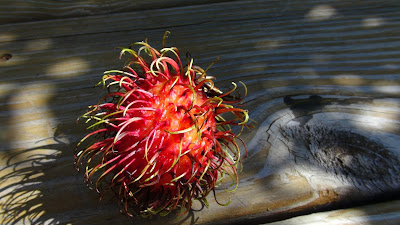Growing Rambutan from seed
BY HEIRLOOM REVIEWS
BY HEIRLOOM REVIEWS
 |
| RAMBUTAN FRUIT |
VIDEO SERIES:
⟹ WALMART : RAMBUTAN - FRUIT REVIEW!!! Sep 22, 2016⟹ WALMART : RAMBUTAN - Planting the seeds!!! PT 1 Sep 27, 2016
⟹ WALMART : RAMBUTAN - Seeds sprouted!!! PT 2 Oct 6, 2016
⟹ WALMART : RAMBUTAN - Getting roots!!! PT 3 Dec 2, 2016
⟹ WALMART : RAMBUTAN - Plant growing!!! PT 4 Dec 28, 2016 latest update
OTHER CHANNELS TO SUBSCRIBE TOO:
⟹ PEPPERS AN PODS CHANNEL: POD REVIEWS AND TASTE TEST
https://www.youtube.com/channel/UCA0u0AcWmi9HZQ98CK2RMWg
⟹ Heirloom Reviews LIVE: LIVE STREAMS AN GOOGLE HANGOUTS
https://www.youtube.com/channel/UCz_y6cWarmwweK7jE2s8lRw
⟹ PATREON: PLEASE DONATE!
https://www.patreon.com/HeirloomReviews
⟹ MINDS: GREAT WEB SITE
https://www.minds.com/HeirloomReviews
⟹ HEIRLOOM REVIEWS WEBSITE: SUBSCRIBE!
https://heirloomreviews.blogspot.com/
 |
| RAMBUTAN FRUIT |
Etymology
The name 'rambutan' is derived from the Malay-Indonesian languages word for rambut or "hair", a reference to the numerous hairy protuberances of the fruit, together with the noun-building suffix -an. In Vietnam, it is called chôm chôm (meaning "messy hair") due to the spines covering the fruit's skin.
Rambutan is native to tropical Southeast Asia and commonly grown throughout Indonesia, Malaysia, Thailand, Vietnam and the Philippines. It has spread from there to various parts of Asia, Africa, Oceania and Central America. The widest variety of cultivars, wild and cultivated, are found in Malaysia.
Around the 13th to 15th centuries, Arab traders that played a major role in Indian Ocean trade introduced rambutan into Zanzibar and Pemba of East Africa. There are limited rambutan plantings in some parts of India. In the 19th century, the Dutch introduced rambutan from their colony in Southeast Asia and Suriname in South America. Subsequently the plant spread to tropical Americas, planted in the coastal lowlands of Colombia, Ecuador, Honduras, Costa Rica, Trinidad and Cuba. In 1912, rambutan was introduced to the Philippines from Indonesia. Further introductions were made in 1920 (from Indonesia) and 1930 (from Malaya), but until the 1950s its distribution was limited. There was an attempt to introduce rambutan to the United States, with seeds imported from Java in 1906, but the species proved to be unsuccessful, except in Puerto Rico.
It is an evergreen tree growing to a height of 12–20 m. The leaves are alternate, 10–30 cm long, pinnate, with three to 11 leaflets, each leaflet 5–15 cm wide and 3–10 cm broad, with an entire margin. The flowers are small, 2.5–5 mm, apetalous, discoidal, and borne in erect terminal panicles 15–30 cm wide.
Rambutan trees can be male (producing only staminate flowers and, hence, produce no fruit), female (producing flowers that are only functionally female), or hermaphroditic (producing flowers that are female with a small percentage of male flowers).
The fruit is a round to oval single-seeded berry, 3–6 cm (rarely to 8 cm) long and 3–4 cm broad, borne in a loose pendant cluster of 10–20 together. The leathery skin is reddish (rarely orange or yellow), and covered with fleshy pliable spines, hence the name, which means 'hairs'. The fruit flesh, which is actually the aril, is translucent, whitish or very pale pink, with a sweet, mildly acidic flavor very reminiscent of grapes.
The single seed is glossy brown, 1–1.3 cm, with a white basal scar. Soft and containing equal portions of saturated and unsaturated fats, the seeds may be cooked and eaten. The peeled fruits can be eaten raw, or cooked and eaten: first, the grape-like fleshy aril, then the nutty seed, with no waste.
Aromatic rambutan flowers are highly attractive to many insects, especially bees. Flies (Diptera), bees (Hymenoptera), and ants (Solenopsis) are the main pollinators. Among the Diptera, Lucilia spp. are abundant, and among the Hymenoptera, honey bees (Apis dorsata and A. cerana) and the stingless bee genus Trigona are the major visitors.
NOTE: All photo's and video's are the sole property of Heirloom Reviews
and are copyright protected an TM. Permission is needed to use any
photo's or video's from any blogs by Heirloom Reviews...

No comments:
Post a Comment